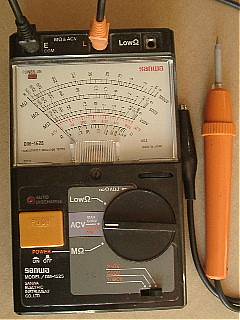Measurement of insulation resistance by megohmmeter
When insulation has worsened though electromechanical apparatus is grounded, the leak breaker works and it doesn't become something useful. Improving the insulation of the equipment becomes a critical factor because of safety.
Megohmmeter

A left photograph is DM-1525 megohmmeter of Sanwa. It is the one to inspect the insulation of insulation and the interior wiring of the equipment.
Even if resistance can be measured even with a usual tester because the test voltage of the tester is 10V or less if it is a measurement of a mere insulation resistance though it seems to be acceptable, safety cannot be secured. The voltage cannot be measured because of the low voltage when there is a space between the semiconductor and wiring.
The inspection voltage of this megohmmeter is DC250V, 500V, and 1000V. The direct current voltage of the minus has gone out. It is necessary to measure the inspection voltage by the voltage more than the peak voltage. If the voltage of ground is 100V of the effect value, it is necessary to measure it with DC150V or more.
According to the extension regulations, in the insulation resistance of low piezo-electric road, it is 0.1M Ohm or more, and 300V in use voltage following are 0.2M Ohm or more in the cable run of 150V or less in the voltage of ground exceeding 150V in the voltage of ground. The cable run that exceeds 300V in the use voltage is 0.4M Ohm or more.
Measuring method of insulation resistance of interior wiring
I think that the thing measured in the switchboard is a lot of of the insulation resistance of the interior wiring. The measurement of the insulation resistance of the interior wiring examines whether the indoor wiring is finally grounded by the resistance of which extent in the place where the coating tears somewhere.
In a word, the interior wiring and the resistance between the earth earths are measured. The decision of the measured voltage seems that it only has to measure it more than the use height voltage (voltage of ground) though is not. Because the peak in the voltage becomes about 150 rout 2 times 107V a V because the voltage of ground is effect value 100V(95V-107V) * note 1 in the type 100/200V of three single phase lines, I think it is good when measuring it with DC150V-250V. I think that you should measure it in one with high voltage of DC500-1000V in the measurement of the insulation resistance when an electric equipment is not connected only by the interior wiring.
Earth electrode is necessary for the measurement of the insulation resistance of the interior wiring. This earth resistance is not cared about even if suitable. In a word, the problem is not in about 1k Ohm either. This need not purposely prepare the earth stick. The reason for the second side of the transformer on the pillar in the electric power company is that it is grounded. Because the line where the center in three electric wires is white is grounded in the type 100/200V of three single phase lines, the insulation resistance between this and each wiring is measured.
As for the insulation resistance only of the interior wiring, to infinity usual in case of building. Almost by ten years - building about 20 even years to infinity usual. When electromechanical apparatus is connected with the outlet, this insulation resistance falls. It is because varistor (ZNR) is connected with the power supply in a recent electric product even if the insulation of the equipment is not bad by a high voltage measures etc. such as Caminari (thunder) of there are a lot of one. Moreover, the bad one of insulation increases, too, when the machine used becomes old.
The electric security society is measuring the insulation resistance of the interior wiring once or more every four years. This inspection is done by the above-mentioned method.
*Note 1
The value that 100V voltage should maintain in Article the Electricity Enterprises Law enforcement rule, the 77th of the trade industry ministerial ordinances, and 44 "Price that doesn't rise about 6V of 101V" The range of 100V voltage of the commercial power : because it provides. It becomes a price that doesn't rise 95V-107V.
Measuring method of insulation resistance of equipment
The power on/off switch of the equipment is put into the state of entering to measure the insulation resistance of an electric product, two lines of the power plug are short-circuited, and it connects it with E of the megohmmeter (earth side). ..power on/off switch.. state of entering should devise the power supply and devise it for the measurement of a structural equipment that doesn't enter.
L of the megohmmeter (high-voltage side) is connected with an external metallic part with the possibility that the earth and the person of the equipment touch and the insulation resistance between power supplies is measured.
Never measure it between power plugs. The equipment might be put out of order. It is the one to connect 100V of the exchange or 200V with the power plug to the last.
DC250V might be too high for the measurement of the insulation resistance of the equipment. Parts that are called the barrister or ZNR have adhered between the earth and AC power of the equipment for lightning and the protection of the equipment by the excess voltage.
The current flows to this barrister by the excess voltage. The voltage when the current flows to this part is selected to 1.41 times of 150V. The varistor voltage is used about 220--240V. In this case, if an equipment is of AC100V, it measures with DC150V--250V.
The measurement of the insulation resistance of this electromechanical apparatus has checked all numbers before the shipment in the manufacturer.